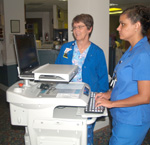New system turns paper to electronic
data
by Mary Helen
YarboroughPublic Relations
A new electronic patient information system is translating into efficiency and on-demand record access for nurses in 10W, 9 PCU and the cardiovascular care unit on 2 Center.
 Registered nurses
Rhonda Flynn,left, and Lenia Christensen check patient's records that
are input on a new mobile computer station in 10W. The electronic
document system is replacing paper records throughout the medical
center.
Registered nurses
Rhonda Flynn,left, and Lenia Christensen check patient's records that
are input on a new mobile computer station in 10W. The electronic
document system is replacing paper records throughout the medical
center. The new clinical documentation system, based on a McKesson software system, went live July 10, and will be expanding into other wings of the hospital in the next several months. A significant “big bang” expansion in September will have the system going live in 8E, 8W, 7E, 7W, 6E, 6W and the Bone and Joint Unit, said Rhonda Flynn, R.N., nurse manager of 10W. Flynn provided input and worked with committees to develop the electronic nursing documentation tool. She and unit educator Anne Anthony also worked to make sure staff were trained and provided practice prior to the actual go live dates.
Though pharmaceutical and physician records remain in paper form, the new system includes admission assessment, a 24-hour record of notes from nurses, a plan of care, which includes an interdisciplinary plan of care by nursing, various therapists and social workers, and patient education, or what the patient has been taught about his condition and treatment.
“This is how we communicate the plan to anyone who would touch that patient, doctors included,” Flynn said.
Pharmaceutical records will be included in the system in October, which will be maintained by the pharmacy and nursing departments; and the computerized physician order entry piece will go live in February, Flynn said. “It will become a totally, paperless electronic medical record,” she said.
The system currently is used by doctors and pharmacists to review care notes. “Prior to that, you had to go to many different places and look at charts,” Flynn said. This took time, and created room for error. With the new system, information is readily accessible in one location on one computer screen.
But undergoing such a tremendous shift has been taxing. Flynn has 40 nurses, and about 200 of the medical center's nurses have gone through training to convert to the system.
While the transition has been helpful for most nurses, a few nurses have reported difficulty with the change and technology.
“It’s been a huge cultural and process change for some nurses,” Flynn said. “But overall, it has gone very well. Nurses are now fully documenting into the new system, and, in fact, they also are improving the system. All of the nurses on all of these units need to be praised and applauded for their efforts in taking this on.”
The electronic clinical documentation reflects a mission to ensure patient safety and optimal care. “There will be no misinterpreting handwriting,” Flynn said. “If a mistake has been made, or if information is inconsistent, a warning will come up if patient safety is at risk.”
The nurses agree that while it’s a huge undertaking, it will improve the overall performance of patient care.
Sylvia Holmes, R.N., admitted being a little hesitant with the new system.
“At first, it was scary,” Holmes said. “But we’ve all adapted. And we’ve learned that when all else fails, hit the miscellaneous button,” referring to a miscellaneous field for patient information.
She said that it has improved the quality of care, and brings to light information that might have been missing in an assessment. While Holmes admits it’s a little time-consuming because of the adjustment, “It will get better. At least everything is in one spot,” she said.
Lenia Christensen, R.N., is a quick learner and had been more accustomed to electronic records at previous nursing jobs. “It’s good that MUSC has gotten this technology,” Christensen said. “For this hospital to be on the cutting edge of all sorts of things and treatment, we should have this system. And it will save lives.”
Friday, Sept. 14, 2007
Catalyst Online is published weekly,
updated
as needed and improved from time to time by the MUSC Office of Public
Relations
for the faculty, employees and students of the Medical University of
South
Carolina. Catalyst Online editor, Kim Draughn, can be reached at
792-4107
or by email, catalyst@musc.edu. Editorial copy can be submitted to
Catalyst
Online and to The Catalyst in print by fax, 792-6723, or by email to
catalyst@musc.edu. To place an ad in The Catalyst hardcopy, call Island
Publications at 849-1778, ext. 201.